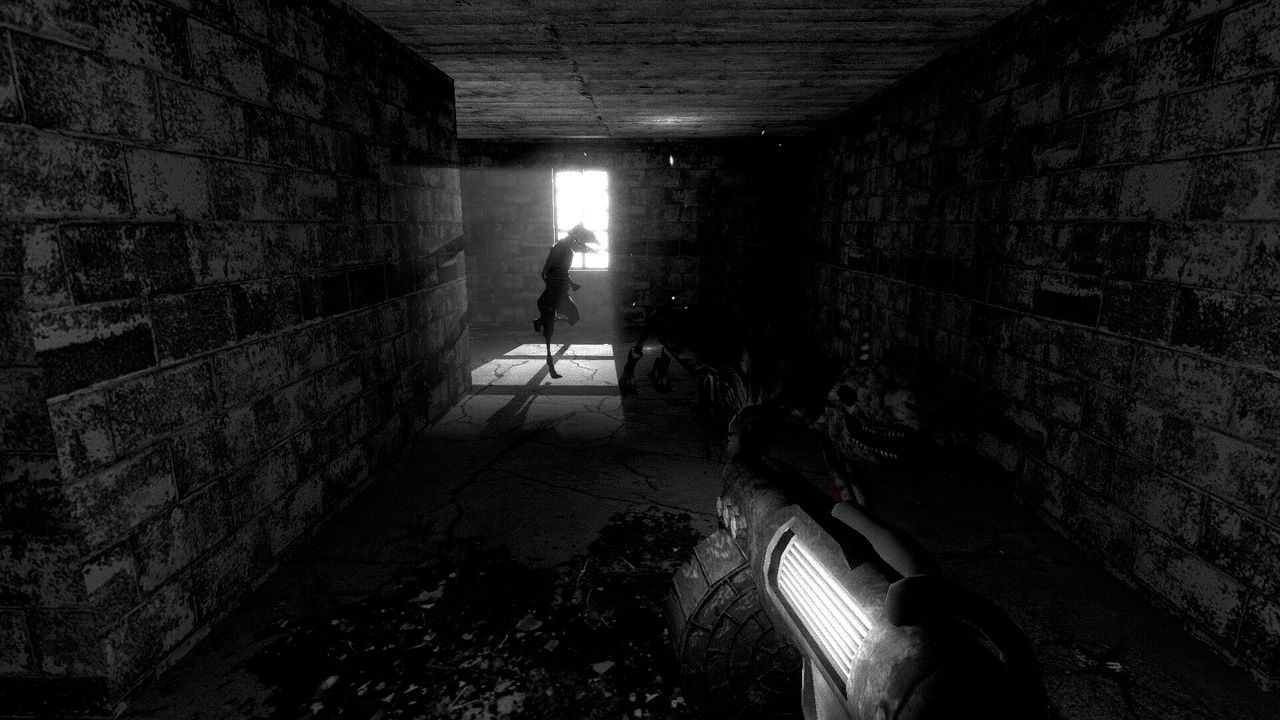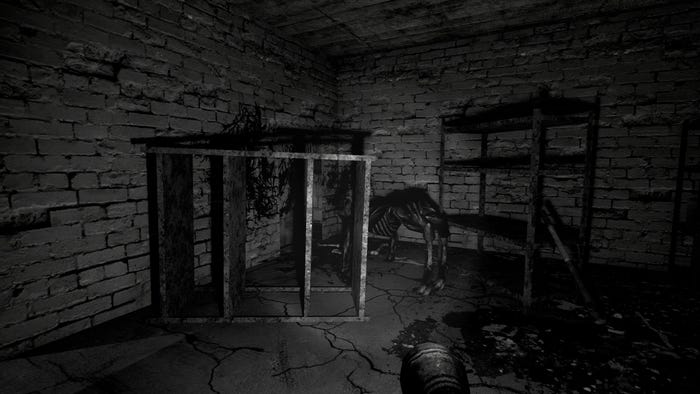Trending
Opinion: How will Project 2025 impact game developers?
The Heritage Foundation's manifesto for the possible next administration could do great harm to many, including large portions of the game development community.

The Pony Factory sees players blasting hellish fusions of horse and man in the pitch black, relying on discomforting sounds and the sparks of gunfire to light up your life before something ends it.
Game Developer caught up with David Szymanski, the game’s creator, to talk about the natural appeal (and absurdity) of making monstrous pony creatures to scare the player in the darkness, the ways they tweaked enemy behavior, combat, and audio so players could fight with the lights off, and crafting a '50s sci-fi feel to the game with its black and white visuals.
The Pony Factory sees us blasting bizarre equestrian monsters in the dark. What inspired the creation of this game?
Szymanski: Unfortunately, I don't have a particularly interesting story about the inspiration behind The Pony Factory. The idea for having humans sort of stretched and twisted into animals came from a Clive Barker story called Jacqueline Ess: Her Will and Testament, where the protagonist takes revenge on someone by psychically mutilating them until they look like a horrible animal of some sort. As far as the rest goes...the magic ponies and hell and stuff...I have no idea. It just seemed like a funny premise.
What thoughts specifically went into the creature designs? What appealed to you about these hellish ponies, and what thoughts went into making them look truly terrifying?
Typically, a horror game with the premise of "we accidentally made evil magic ponies" would be about taking something innocent and making it creepy, similar to any number of mascot horror games or the classic My Little Pony creepypastas, for that matter. But for me, The Pony Factory was less about juxtaposing wholesomeness and horror and more about the absurdity of ascribing wholesomeness to something that is entirely not wholesome. Put another way, I think it's funnier to have "magical ponies" that don't look magical in the slightest than to have Rainbow Dash with no eyes or whatever.
The guiding principle for The Pony Factory's story was that everything Winston did was a terrible, TERRIBLE idea, from moment one. And the more incredibly obvious that is to the player, the funnier I think it is. Winston and an entire factory's worth of employees spent months flaying and grafting victims into these horrifying, disfigured abominations of horse and man while glue fumes were deliberately pumped into the air and the literal collective embodiment of evil itself is in charge, and expected that somehow they would get "magic ponies" out of the whole deal.
One of my favorite jokes that sadly didn't land for a lot of people was early on when a note is calmly explaining that the pools of literal liquid electricity are no cause for concern because lightning cannot travel through the air. Lightning can, in fact, travel through the air. That's pretty much all lightning does.
Anyway, from the very beginning, I wanted to make horrible horse monsters, and since I find horse/deer skulls to be kind of terrifying on their own, I knew that's what the head needed to look like. Although thinking about it now, it could have been just as unnerving to have a fully intact horse head grafted onto a human body. But regardless, with the rest of the body, it made sense to go with this uncomfortable muscley look to compliment the skull, like all the skin had gotten torn off, and then just add hooves instead of human limbs, and voila, magic ponies! The final addition was their dumb little unicorn horn, just to add a little bit of "we tried to make this look whimsical, m'kay?"

Images via David Szymanski.
What ideas went into how these creatures would behave and attack the player?
Originally, I'd wanted to make the combat play out like encounters with the HECU soldiers in Half-Life. That is, both the player and enemies are constantly moving around the combat space, exchanging shots, advancing, retreating, taking cover, etc. Since I only had a week to develop the original release, the AI never quite got to that point, but it was close enough to combine with the flashlight system to give fights the high-speed, cat-and-mouse feel I wanted. That's the bipedal enemies, at least. The ones on all fours just do some very basic pathing to the player and attacking when close enough, and, I believe, will sometimes retreat. They're mostly patterned after the aliens in the first two Aliens vs Predator FPS games, and their job was to give the player a chance to get a feel for the gameplay before throwing harder enemies at them, as well as to make the player paranoid of every new hallway and room.
Players can choose to have their flashlight or their gun out, but not both. How did this affect the overall design of the game? How did it affect things like level design, weapon attacks, etc?
Even before I'd settled on the story premise, I knew I wanted the gameplay to be about fighting enemies in the dark and having to use things like muzzle flash, sparks, sound, etc, to keep track of enemies. It was, of course, directly inspired by Doom 3 doing basically the same thing, and I wanted to explain, in game form, why that mechanic is very fun and interesting. I have no idea if it worked, but people seem to like The Pony Factory, so I'll assume it did.
It didn't affect the level design necessarily, but it certainly affected how I designed the effects for player and enemy attacks. Bipedal enemies will give you a moment of both wind-up and visibility as they charge their luminous attacks, and your gun will light the area with both muzzle flash and sparks, so shooting is as much a way to see during fights as a way to do damage. That's also the reason enemies make constant noise. So, even in the pitch black, you have some idea where they are.
As sound is a vital tool for fighting back against these creatures, can you tell us about designing the sound effects for the game and how you created them?
Honestly, there isn't much to tell. Aside from the importance of hearing enemies and making the gun sound good, most of the sound was as much about making stuff that was usable as quickly as possible. And as it turned out, "good enough" was good enough for the game, and there wasn't much that I needed to do for the standalone other than adjusting some of the balance and mixing (and writing a new music track for the end, of course!).
What development challenges came from designing a game around light, or the lack thereof?
Once different attacks created light and enemies had active sounds, it was surprisingly easy to design everything else. At least as far as designing the game around light/darkness is concerned. Since the player can use their flashlight at any time, the darkness is only a concern when combat is happening, and as I said, a lot of that was just giving the player tools/moments to take advantage of.

Images via David Szymanski.
Why make the game in black and white? How do you feel this enhanced the design and feel of what you were creating?
Making The Pony Factory black and white was actually one of the earliest decisions made before I'd even settled on the premise. I'd wanted to make a high-contrast black-and-white game for years, ever since playing the game Betrayer. Making a 7-day game seemed like the perfect opportunity to do that. So, the whole '50s sci-fi vibe and everything followed from that. And, of course, when we're talking black and white, playing with light and shadow in different ways is a natural fit.
The Pony Factory is a brief experience. Were there things you felt you could do more with a short horror game? What drew you to make a short horror experience, and what do you feel it allowed you to do that might not be feasible in a longer experience?
There are plenty of examples of longer games that remain consistently scary throughout or successfully build tension over the course of many hours, but I personally find myself conceptualizing horror in the short term, whether I mean to or not. I'm not sure I could even say what you can do with a short horror game that you can't do with a longer horror game because, honestly, I've never done any sort of long-form horror. The closest I have would be Dusk, which, in reality, consists of a few short-form horror moments with lots of straight-up action in between. I have a few concepts for longer horror games that I'd love to try. Maybe someday soon.
This version builds upon the original release of the game from the Dread X Collection. What made you want to come back to it? What thoughts went into building upon that release and enhancing it?
At first, I just wanted to do a few quality-of-life improvements and release it for 99 cents or for free or something like that, but as Johnny (Szymanski) and I were working on it, we kept coming up with other stuff to improve or add. The original release was okay but definitely showed its short development time, and when it became clear that the standalone release was going to be more robust than just a few bug fixes and features, I decided to fill in some of those holes. Namely, the second half always needed a little something to change up the gameplay, the story needed more than just beginning and ending text, and there should have been a final boss.
So, The Pony Factory actually ended up turning into something I'm pretty fond of now, and proud to show to people, rather than just an exercise in speed game dev. In particular, I was glad to be able to add some more lore and depth to the story (which is now probably one of the stupidest things I've ever written, and I love it) and to officially make it and Squirrel Stapler take place in the same world (something I'd always assumed but was never official). That will pay off even more when Butcher's Creek is done, as its story relates to the events in Squirrel Stapler and The Pony Factory.
You May Also Like